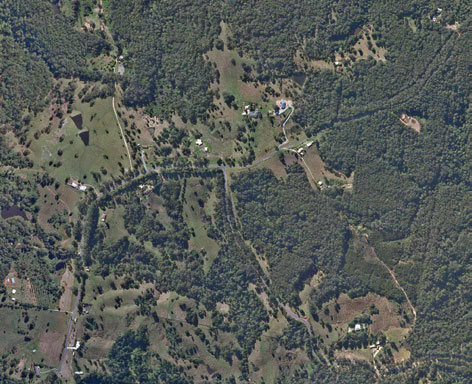
A common sight on Land for Wildlife properties: a big pile of dead lantana.
Both Spencer Shaw in the October 2012 newsletter and Peter Darvall in January 2013 have suggested that non-native species are sometimes valuable and should not automatically be eradicated.
I wish to suggest three criteria to apply when deciding whether to destroy a plant or encourage it. As Spencer and Peter remark, origin of the plant (indigenous, Australian or exotic) by itself is inadequate.
The first test is, what is the intended land use? In all parts of Queensland the landscape is now fragmented. We cannot assume that pure native bushland everywhere is the ideal. A mosaic usually supports a wider range of species than a single vegetation formation. Most Land for Wildlife properties carry a mosaic: on our family’s acreage, about half is orchard and pasture – only half is regenerating rainforest.
Planning a property then laying out fences to segregate land uses are complex tasks and I urge any Land for Wildlife members seeking to do so for the first time, to fireup a barbecue and invite some experienced landholders and your Land for Wildlife Officer to brainstorm the design.
The second criterion is the current distribution of the plant. Cobbler’s Pegs and Wild Tobacco are ubiquitous throughout South East Queensland and rarely need to be controlled for the purpose of preventing spread. But for any plant which has not reached the limit of its expansion, prevention is the most prudent strategy. Broad-leaf Privet is gearing up for a dramatic expansion in SEQ and wherever eradication is practicable, I would eradicate.
The third criterion is the aggressiveness of the plant. Most exotic herbs fade away rapidly under shade. But others like Cat’s Claw Creeper are an emerging catastrophe as they can smother even mature trees.
To apply these criteria combined, landholders are obliged to become knowledgeable about the identity and ecology of each plant being reviewed. For example, our property supports a native Eragrostis grass and an exotic Eragrostis, a rapidly spreading denizen of roadsides that looks similar but is a menace. I pounce on every single plant of the latter that shows its head. Soil preferences, sensitivity to competition, palatability to cattle and so on must each be understood if the plant’s potential to spread or to disrupt the chosen land use is to be evaluated.
The statutory list of regulated noxious weeds is not particularly useful for this purpose. It is conservative (because the State does not wish to expend funds on more weeds than the minimum), so many undesirable plants that ought to concern the Land for Wildlife members don’t appear. The converse is less valid: any plant that appears on the statutory list should be regarded as a potentially serious weed.
I am wary of applying the usefulness of a particular weed for particular species of wildlife – as a fourth criterion – because of ecological complexity. Yes, Wild Tobacco is good for brown doves, but what other species are being poisoned by its exudates; and how many brown doves can the locality support without elbowing out other more vulnerable species?
No article on this subject can be complete without asking if lantana is a useful plant or an intolerable pest. It can be both, and both on the one property.
May this newsletter long serve as a forum for sharing knowledge and insights on these issues.

Mosaics tend to be richer in wildlife than pure native vegetation because of edge effects and their suitability for the species of open grasslands or wetlands.
GIS image of Mt Mee region courtesy of SEQ Catchments.
Article by Geoff Edwards, Land for Wildlife member, Mt Mee, D’Aguilar Range
View Full Newsletter

Interesting article. I’m curious whether the assertion that “Mosaics tend to be richer in wildlife than pure native vegetation…” is an established fact or more of a hypothesis.
Hi Keith. We agree that it is a broad statement and would really depend on the type of ecosystem and site specifics. A general rule of ecology is more diversity of habitat = more diversity of species, but obviously there are exceptions to this rule, but broadly, that is what is being asserted here.
i don’t have a comment on the article but I am looking to identify a small plant in our paddock in Ocean View. It is a narrow leafed plant with 2 cm yellow flower with 5 petals. The petals are heart shaped. The plant has a low growing profile.
Ive been onto various web sites but had no success so far.
Hope this isnt too presumptious!
Hi Kay. You may wish to upload your photos to the Qld Native Plant Identification Facebook page for identification.
https://www.facebook.com/p/Queensland-Native-Plant-Identification-100066463007528/